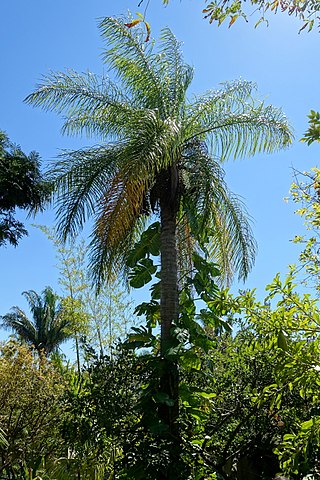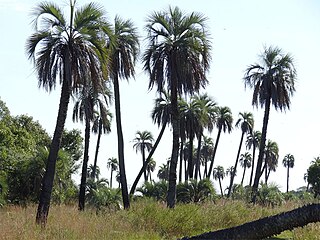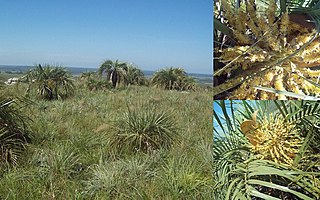
The Gran Chaco or Dry Chaco is a sparsely populated, hot and semiarid lowland tropical dry broadleaf forest natural region of the Río de la Plata basin, divided among eastern Bolivia, western Paraguay, northern Argentina, and a portion of the Brazilian states of Mato Grosso and Mato Grosso do Sul, where it is connected with the Pantanal region. This land is sometimes called the Chaco Plain.

Copernicia prunifera or the carnaúba palm or carnaubeira palm is a species of palm tree native to northeastern Brazil. Known by many as 'tree of life' because of its many uses, the Carnaúba is also the symbol tree of Ceará. The initiative to use it as a symbol vies to promote its conservation and sustainable use.

Prosopis alba is a South American tree species that grows in central Argentina, the Gran Chaco ecoregion, and part of the Argentine Mesopotamia, as well as Bolivia, Chile, Paraguay, and Peru. It is known as algarrobo blanco in Spanish. Spanish settlers gave it that name because of its similarity to the European carob tree. Other common names come from Guaraní, including ibopé and igopé.

Prosopis nigra is a South American leguminous tree species that inhabits the Gran Chaco ecoregion, in Argentina and Paraguay. It is known as algarrobo negro in Spanish, which means "black carob tree". It is also variously called algarrobo dulce, algarrobo morado and algarrobo amarillo.

Stetsonia coryne, the toothpick cactus, is the sole species in the cactus genus Stetsonia. Stetsonia coryne is native to arid regions of South America, where it grows to a height of 15 to 25 ft tall. It contains mescaline and other alkaloids.

Acrocomia aculeata is a species of palm native to the Neotropics.

Ceroxylon quindiuense, often called Quindío wax palm, is a palm native to the humid montane forests of the Andes in Colombia and Peru.

Prosopis kuntzei is a South American leguminous tree species that inhabits the westernmost Gran Chaco forests covering areas of Argentina, Bolivia, and Paraguay, where it acts as natural component. It has also been able to colonize the nearby pasture sabanas. It is commonly referred to as itín, palo mataco, carandá or barba de tigre. It is adapted to arid climate, but can also survive flooded ground for a long time.

Trithrinax campestris, the caranday palm, is a South American palm tree native of Uruguayan and northeastern Argentine sabanas, where it shares its habitat with Copernicia alba among others and extends also to the summits of mountain ranges of Sierras de Córdoba and Sierras de San Luis. It is a very rustic palm that grows in arid, well drained, rocky soils. Its distinctive features are its compact shape, short green to grayish foliage, and trunk fully hidden by dry dead leaf bases (coat) remaining from several previous seasons.

Cryptocarya alba, the peumo or Chilean acorn, is an evergreen tree that grows in Chile and Argentina from 33 to 40° southern latitude. It can live both in wet and as in dry conditions. Its distribution can reach up to 1500 meters (5000 ft) above sea level. It measures up to 20 meters (65 ft) height and one meter diameter, with cracked gray bark. An associate tree is the endangered Chilean Wine Palm, Jubaea chilensis, which species prehistorically had a much wider range.

Copernicia hospita is a palm which is endemic to Cuba.

Copernicia macroglossa, is a species of palm endemic to western and central Cuba.

Mburucuyá National Park is a national park in Argentina. It is located in the north west of the Corrientes Province around 150 km (93 mi) from the city of Corrientes and covers an area of 176 square kilometres (68 sq mi) of the Iberá Wetlands.

Butia paraguayensis is a species of Butia palm tree found in the cerrado region of South America. Its natural range runs from Mato Grosso do Sul and São Paulo in southern Brazil through Paraguay to northern Argentina and Uruguay. It was given the name dwarf yatay palm in English by 2000, and it is locally known as yata'i in Guaraní in Paraguay, or butiá-do-cerrado in Portuguese in Rio Grande do Sul, Brazil.

Butia yatay, the jelly palm or yatay palm, is a Butia palm native to southern Brazil, Uruguay and northern Argentina. It is known as the butiá-jataí in Portuguese in the south of Brazil, as well as simply jataí or butiá. It is sometimes cultivated as an ornamental in Europe and the United States. It is the tallest of all the species in the genus Butia. The fruit is edible with a sweet flavour.

Ptychosperma elegans, commonly known as the solitaire palm, is a very slender palm endemic to Queensland in Australia. In the nursery trade and in the United States it may be confusingly referred to as Alexander palm, which is an often-used but misnomered name of another Australian palm species Archontophoenix alexandrae, the Alexandra palm.

Hymenaea stiginocarpa is an irregularly shaped, mostly 6–9 m (20–30 ft) high tree that has been assigned to the pea family. It has a twisted spindle-shaped trunk, a very rough grey bark, and reddish-brown twigs. The deciduous leaves consist of two large asymmetrical leaflets with an entire margin. The flowers occur in clusters of up to thirty at the end of the branches. It produces edible, highly appreciated fruits, which are often collected from the wild and used by local people. The vernacular name of this species in Brazil is jatobá do cerrado.

Butia campicola is a very small species of Butia palm with an underground trunk; native to the cerrados of central Paraguay and south-central Brazil.
Butia arenicola is a very small species of Butia palm with an underground trunk; native to Paraguay and the state of Mato Grosso do Sul in Brazil. Boquierinho is recorded as a possible local vernacular name for it.
Butia matogrossensis is a smallish species of Butia palm with a trunk of only 0.5 m (20 in) in height or often subterranean, native to the cerrados of the centre, central-east, northeast and likely north of the state of Mato Grosso do Sul, after which it is named, in south-central Brazil. It also occurs in neighbouring south-central Goiás to the north. It is endemic to Brazil, occurring only in this country.



















